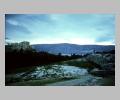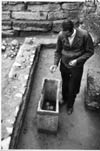Ariadne:
Resources for Athenaze
Chapter22 |
Images |
Athenian Democracy in Action: The Pnyx, the Bouleuterion, the Prytaneion, and the Heliaia
Clicking on the thumbnail will open a new browser window.
 |
The ecclesia (assembly) consisted of all adult male Athenian citizens and met on the Pnyx, a hill close to the Acropolis. Even though all citizens were expected to attend, a crowd of about 6000 was probably normal. What was and still is radical about Athenian democracy is that each freeborn male was eligible to vote in the assembly. |
 |
After a prayer was offered to the gods and a libation was poured, the kerux (herald) announced the probouleuma (the preliminary decree). If the ecclesia wanted to debate it, the herald would then ask, "tis agoreuein bouletai?" (who wants to speak?). Then theoretically any citizen could come forward and speak from the bema (the speaker's platform). In fact, it was usually trained rhetores (speakers) who came forward. In the photo, it is possible to see the bema and the steps leading up to it. |
 |
Yet not everyone had time to attend the ekklesia, let alone have time to oversee the polis. Therefore, each of the ten tribes of Athens selected 50 of their number to act as bouleutai (advisors). The 500 total bouleutai (10 tribes x 50 advisors) met in the agora in a building called the Bouleuterion. The plan on the left is a reconstruction of how the seating may have worked. Click here for a perspective view. When they met, they deliberated (bouleuein) about what proposals (to probouleuma) they should present to the ekklesia. |
 |
The bouleutai delegated day-to-day responsibilities of running Athens to 50 prytaneis (presidents) who met and had their meals in a round building called the Prytaneion. Although Greeks normally ate their meals reclining, if they remained seated upright, it would be possible to fit all 50 prytaneis into this building. Such a practice parallels ritual dining in some Greek sanctuaries where temporary tents were set up for diners. Click here for a hypothetical reconstruction of the roofing. |
| As a check on any one individual becoming too powerful, once a year the assembly was asked if it wanted to ostracize someone (send them into exile) for ten years. The name of the person to be exiled was written on an ostrakon (potsherd). This ostrakon has the name of Themistocles. | |
| The lawcourts (Heliaia) are the most difficult to find archaeologically. That is because they met in open-air spaces with none or wooden seating. The size of Athenian juries varied from the smallest of 201 up to the largest of 5001. But a ballot box has been found in which jurors would place their ballot voting for acquittal or not. Each juror would receive two ballots, sometimes labeled psephos demosia. The juror would deposit the ballot with a solid axle if they thought the defendent was innocent or a pierced axle if guilty. | |
| A kleroterion (an allotment machine) has also been found in the Agora Excavations. It was used to select jurors at random (i.e. by lot). Jurors' tags were placed in the slots. On the far left was a tube through which a white or black ball would fall. If the white ball emerged, then all the people in the first row (one from each tribe) would be selected for jury duty, but if the black ball came out, then instead they would be sent home for the day. | |
| A klepsydra (water clock) was used to help time speeches during trials. The water clock shown here, from the tribe Antiochis, held about two choes (6.4 liters) and ran for about six minutes. |
Visit Andrew Wilson's interactive tour of the Athenian Agora at the end of the 5th century BCE.

